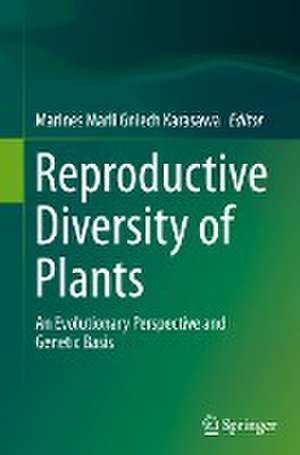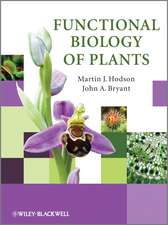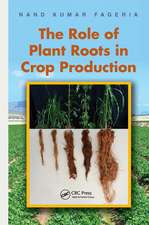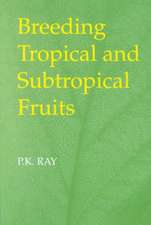Reproductive Diversity of Plants: An Evolutionary Perspective and Genetic Basis
Editat de Marines Marli Gniech Karasawaen Limba Engleză Hardback – 2 dec 2015
The last part discusses the biology and genetics of the reproductive systems and shows the strategies that modern plants use in asexual reproduction (vegetative and apomictic reproduction) and sexual reproduction. In addition, the sexual reproduction topics such as gametogenesis, the genetic control of reproductive organs, systems that promote outcrossing, selfing and mixed mating systems were also included.
| Toate formatele și edițiile | Preț | Express |
|---|---|---|
| Paperback (1) | 631.07 lei 6-8 săpt. | |
| Springer International Publishing – 23 aug 2016 | 631.07 lei 6-8 săpt. | |
| Hardback (1) | 556.65 lei 38-44 zile | |
| Springer International Publishing – 2 dec 2015 | 556.65 lei 38-44 zile |
Preț: 556.65 lei
Preț vechi: 695.81 lei
-20% Nou
Puncte Express: 835
Preț estimativ în valută:
106.53€ • 115.67$ • 89.48£
106.53€ • 115.67$ • 89.48£
Carte tipărită la comandă
Livrare economică 18-24 aprilie
Preluare comenzi: 021 569.72.76
Specificații
ISBN-13: 9783319212531
ISBN-10: 3319212532
Pagini: 168
Ilustrații: XIII, 87 p.
Dimensiuni: 155 x 235 x 12 mm
Greutate: 0.35 kg
Ediția:1st ed. 2015
Editura: Springer International Publishing
Colecția Springer
Locul publicării:Cham, Switzerland
ISBN-10: 3319212532
Pagini: 168
Ilustrații: XIII, 87 p.
Dimensiuni: 155 x 235 x 12 mm
Greutate: 0.35 kg
Ediția:1st ed. 2015
Editura: Springer International Publishing
Colecția Springer
Locul publicării:Cham, Switzerland
Public țintă
ResearchCuprins
1.Evolution of plants with emphasis on its reproduction form.- 1.1 First plants and the alternation of generations.- 1.2 Homospory, heterospory and the evolution of egg and polen grain.- 1.3 The evolution of terrestrial flora.- 1.4 Evolution of pro-gymnosperms and gymnosperms.- 1.5 Evolution of angiosperms.- 1.5.1 Unisexuality and the reproductive strategies.- 1.5.2 Evolution of unisexuality.- 1.5.3 Evolution of the self-incompatibility system.- 1.5.4 Evolution of the self-fertilization system.- 1.5.5 Evolution of mixed mating system.- 1.6 Evolutionary implications.- 1.7 Bibliography.- 2. Biology and genetics of reproductive systems.- 2.1 Introduction.- 2.2 Asexual reproduction.- 2.2.1 Vegetative reproduction.- 2.2.2 Apomictic Reproduction.- 2.3 Sexual Reproduction.- 2.3.1 Gametogenesis and fecundation.- 2.3.2 Genetic control of the reproductive organs.- 2.3.3 Systems promoting allogamy.- 2.3.4 Autogamy.- 2.3.5 Mixed System.- 2.4 Bibliography.
Notă biografică
Graduated in Agronomy at Universidade Federal de Pelotas - Rio Grande do Sul, Brazil (1993), Masters of Science in Zootechny - Grasslands and Pastures at Universidade Federal de Lavras - Minas Gerais, Brazil (2001) and Doctorate in Agronomy - Genetics and Plant Breeding at Universidade de São Paulo, ESALQ - São Paulo, Brazil (2005). Scientific reviewer of the Biología Tropical, Arvore, SciEP, Asian Pacific Journal of Tropical Disease, Integrated OMICS, Agricultural Science and Technology, Brazilian Agricultural Research (PAB) journals, Foundations that Supports Research in Bahia (FAPESB) and to the Sao Paulo University (USP – CENA).
Textul de pe ultima copertă
The first part of the book presents the evolution of plants starting from photosynthetic cells to topics like Gymnosperms and Angiosperms, including the evolution of the breeding system. Geological and molecular data were used, helping us to show with more details each of the phases presented. Also, specialization of the reproductive systems such as evolution of unissexuality (dioecy and monoecy), evolution of self-incompatibility, selfing fertilization and mixed mating systems were considered.
The last part discusses the biology and genetics of the reproductive systems and shows the strategies that modern plants use in asexual reproduction (vegetative and apomictic reproduction) and sexual reproduction. In addition, the sexual reproduction topics such as gametogenesis, the genetic control of reproductive organs, systems that promote outcrossing, selfing and mixed mating systems were also included.
The last part discusses the biology and genetics of the reproductive systems and shows the strategies that modern plants use in asexual reproduction (vegetative and apomictic reproduction) and sexual reproduction. In addition, the sexual reproduction topics such as gametogenesis, the genetic control of reproductive organs, systems that promote outcrossing, selfing and mixed mating systems were also included.
Caracteristici
Shows the evolution of plant reproductive system with molecular and geological data Discuss plant reproductive systems with a biologic and genetic approach Presents many figures that may help simplify and understand the complex topics discussed






